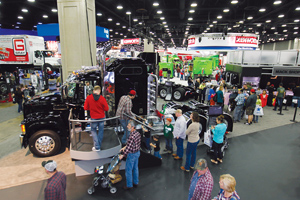Optimism Prevails at MATS

This story appears in the April 7 print edition of Transport Topics.
LOUISVILLE, Ky. — A strong consensus that 2014 heavy-duty truck sales could be more robust than North America has seen in recent years replaced the hoopla and fireworks often associated with product unveilings at the Mid-America Trucking Show.
Original equipment manufacturers said that after years of improving truck and engine designs during times of modest sales growth, they now expect accelerating volumes that should last at least through next year.
“2014 could be the year that the dam breaks,” said Wolfgang Bernhard, head of Daimler AG’s global commercial vehicle operations.
More than 79,000 people passed through the doors of the Kentucky Exposition Center here March 27-29, the third-largest total in the show’s 43-year history.
Also during MATS, American Trucking Associations and other industry groups officially kicked off a “Trucking Moves America Forward” image campaign with the need for more drivers playing a prominent role, said ATA Vice Chairman Kevin Burch, a truckload carrier executive.
Meanwhile, higher demand has led Daimler Trucks North America to increase its build rate by 100 more trucks a day than it was making late last year.
Likewise, Göran Nyberg, president of Volvo Trucks in North America, said his company will hire 200 more people for its Virginia plant based on sales expectations.
“Everybody is singing out of the same hymnbook. They’re incredibly optimistic that 2014 will be one heck of a good year for the industry,” said Gary Meteer Sr., who attended MATS for IHS Automotive’s Polk division. The company’s director of commercial vehicles, Meteer estimated this should be the best year for U.S. Class 8 vehicle registrations since the 2006 record.
MATS raised “confidence that a sustainable truck cycle is under way,” analyst David Leiker of Robert W. Baird wrote in an investor note. “Truck demand is being driven by freight growth outpacing productivity; this supports fleet expansion across all customers.”
Daimler’s Bernhard said more small- and medium-size fleets are entering the market. In addition, there is growing interest for rental vehicles, which he said is a sign of the increasing demand, but that people are not yet convinced a true economic rebound will take hold.
Trailer makers said they expect sales to grow in tandem with tractors.
ACT Research Co. expects to see “consistent” production of trailers over the next three to five years as fleets replace older equipment and respond to increasing demand for freight service, said Frank Maly Jr., ACT’s lead trailer analyst.
Several OEMs and suppliers used a green-yellow-red coded stoplight metaphor in their press presentations, with the colors standing for clear growth, caution and danger. Green outnumbered yellow; and red was not to be found.
However, two consistent caution points were the shortage of truck drivers and the stubbornly high unemployment rate.
IHS’ Meteer said he is eager to see first-quarter registration figures, but the company’s current forecast calls for 208,000 to 210,000 new U.S. Class 8 registrations, or slightly better than 2004 — recognized as a strong year.
This year featured the intricate technological innovations of tractors, trailers, components and other systems. Truck and engine makers returned their focus to diesel fuel rather than natural gas, which had been a major story the past several years. Fuel-optimization packages were touted, too, such as the Kenworth Trucks T680 Advantage, the Peterbilt Motors 579 Epiq, Volvo’s XE combination for extreme efficiency and Freightliner Trucks’ latest version of the Cascadia Evolution.
Volvo Group and Daimler said their homegrown engines are synchronized with the transmissions they also make, adding small — but precious — fractions to miles-per-gallon numbers. Engine maker Cummins Inc. and transmission provider Eaton Corp. said their combination is every bit as harmonized.
Every facet of the tractor is chiseled to minimize aerodynamic drag, and fairings are added for the same purpose. Tire makers also are marketing based on fuel efficiency and axle makers are adjusting the ratios in their differentials to nurse a little more mileage out of a gallon of fuel.
There was also discussion of “uptime” as delivered by remote diagnostics, which sends information on vehicle problems ahead to dealerships so repair work can begin even before the truck gets there.

